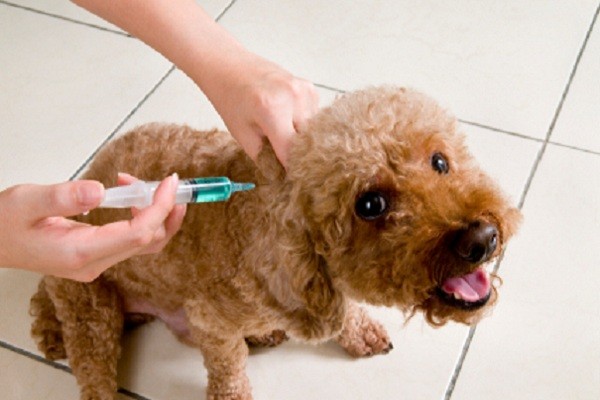It’s no surprise to many disgruntled pet owners that many veterinary clinics rely on revenue from vaccines. Happily for the dogs, many vets have replaced vaccinations with titer testing. The problem with this is twofold: one, they are replacing yearly or triennial vaccination with yearly or triennial titer testing, and two, titers are expensive.
Once a dog has a positive titer, he is considered protected for life. This means he no longer requires more vaccinations (most of the core vaccines have been shown to protect dogs for 7 to 15 years). If the dog doesn’t require any other vaccinations, then why are the titers being repeated?
“The patient receives no benefit and may be placed at serious risk when an unnecessary vaccine is given” says Dr. Ronald Schultz. ”Few or no scientific studies have demonstrated a need for cats or dogs to be revaccinated.” Clearly, not only repeating a vaccination, but repeating a titer is unnecessary. Although repeated vaccinations place your pet at risk, repeated titers place your pocketbook at risk.
The fee for titer testing varies from region to region and lab to lab however the going rate for a distemper/parvovirus titer is from $40 to $60 and the rabies titer will average about $120 (plus the cost of an office visit). Fortunately, there is a cheaper alternative to titer testing.
Last year, Biogal rolled out its Vaccicheck in the US. Synbiotics also has their TiterCHEK test, which they recently sold to Pfizer. Both tests measure parvovirus and distemper and the Vaccicheck also measures adenovirus. Vaccicheck also has a test for cats. Whereas titers traditionally had to be sent out to labs for analysis, these two tests are performed in-house, greatly reducing costs.
If your dog requires repeated titers for his daycare, boarding kennel or training club, these two tests are a much cheaper alternative to traditional titer testing. Both tests are easy to use and provide an answer (protection or not) within 20 – 30 minutes. Both tests have been validated independently and correlated with gold standard tests by a number of diagnostic laboratories.
If your vet isn’t aware of these tests, urge him to start using them in place of titers. Not only will they be cheaper for you, they may save another dog from over-vaccination. Many pet owners (and vets) opt out of titers because of the cost, but at a price tag of around $20, these in-house tests are cheaper than vaccinating. Do your part in the fight against over-vaccination and inform your vet of these great new alternatives.
Titers, what do they mean?
Viruses can not replicate on their own and must invade our bodies and hijack our cells and cellular machinery to replicate. This means that once a virus invades our body, it is in our own cells. The defense system against these viruses is twofold and can be divided into cellular immunity and humoral immunity.
As the name implies, cellular immunity works on a cellular level where T cells are able to detect which of our cells contain the unwanted virus and work to destroy it. When our T cells are activated against a virus, they file the information away for future use and this allows them to respond much quicker the next time the body is faced with the virus. These cells are always reproducing and they pass this memory on to their ‘children’ and this memory exists for life. This explains how we are immune to many viruses after getting them once.
Humoral immunity is like the front line troops that work outside the cellular fortress: it is the first line of defense. Humoral immunity occurs in the body fluids where B cells float around on sentry duty. When B cells come into contact with antigens (for example, proteins from a virus), they activate antibodies which identify and neutralize foreign proteins. Each antibody is responsible for a different antigen, so some might be responsible for distemper, some for parvovirus, etc. After an antibody is successful at neutralizing any antigens, it will float around the body for years, working as a sentry. Like T cells, B cells develop a memory which allows them to respond quicker and with more force the next time they come across the same virus.
A titer is capable of measuring only a small part of the active immune system: the circulating antibodies. If a titre is high, it is a good assumption that the immune system is perfectly capable of a successful response to the antigen in question. So if your dog has a high titer for parvo, it is extremely unlikely that he will suffer the disease, even if he is exposed to parvovirus. If there are parovovirus antibodies circulating in his system, then the immune system is fully armed and ready to protect him.
What if the circulating antibodies are low? Does that mean that immunity is low? Well, the answer is no. Immunity is an all or nothing thing: a dog is either immune or he is not. There is no grey area or sliding scale. According to Dr. Ronald Schultz, any amount of titer means your dog is protected.
If a titer is zero, it really has no predictive value. Memory cells exist for the life of the animal but circulating antibodies may or may not. Just because circulating antibodies are low (and therefore the titer is low), does not mean that your dog can not fight infection if exposed to parvovirus (or any other virus). There may not be circulating antibodies present, but the memory cells are there and waiting to launch a quick and powerful attack on parvovirus antigens, activating the antibodies and neutralizing any threat.
Based on this, what is the predictive value of a titer? Well, any amount of titer has a very good predictive value. If a there is any circulating antibody present, then your dog is either suffering from the disease or has successfully fought it in the past and can expected to do so in the future without further vaccination. If a titer is zero, then it is of little value as it comes down to guesswork.
In order to avoid the possibility of a negative titer, the best practice is to titer a puppy right after vaccination. If you were to vaccinate a puppy and run a titer about three weeks afterward, it would have wonderful predictive value. If there is any amount of titer, then there are circulating antibodies against the parvo or distemper virus. If this is the case, then it is extremely likely that memory cells will have been produced and your puppy is protected for life. There is no need for further titers and certainly no need for further vaccination. This would be the best use of a titer test as a negative titer would now have predictive value, meaning there was either vaccine failure or passive immunity (maternal antibodies) blocked the vaccine (which is possible for up to 26 weeks of age with parvovirus).
If more vets, breeders and puppy owners used titers in this manner, instead of simply vaccinating at three or four week intervals, trying to catch the period in time when passive immunity is low enough for the vaccine to work, most puppies would only need to be vaccinated once instead of multiple times. It would take a lot of the guesswork out of a vaccine schedule and eliminate the need for unnecessary and potentially dangerous vaccinations.
Be aware of annual vaccinations
In 2008, Elizabeth Hart’s dog died within days of receiving an annual booster on “core” vaccines. Vaccination boosters are not only unnecessary but in most cases cause adverse reactions and even death. This devastating experience started Elizabeth on a long journey of exhaustive research and frustrated dealings with the veterinary profession and regulators.
The basic issue, she believes, is one of informed consent and that pet owners should be properly informed of the risks. Elizabeth states: “my argument is against unnecessary vaccination of pets that have already responded to core vaccination, as the World Small Animal Veterinary Association’s (WSAVA) Guidelines for the Vaccination of Dogs and Cats note that “…duration of immunity (DOI) is many years and may be up to the lifetime of the pet.” (Ref: WSAVA 2010 guidelines: http://www.wsava.org/PDF/Misc/VaccinationGuidelines2010.pdf
It is unacceptable that dogs be subjected to unnecessary interventions that can cause harm. The ‘informed consent’ of the pet owner should be obtained before any intervention takes place.
If pet owners want to verify that their dog has responded to core vaccination, they can opt for a titre test. (I understand titre testing is available for around $90-$100 from some vets.) I have seen no evidence that repeated titre testing is necessary.
On the topic of adverse reactions to vaccination, the WSAVA 2010 guidelines acknowledge that “there is gross under-reporting of adverse events which impedes knowledge of the ongoing safety of these products”.
The WSAVA 2010 guidelines also warn “we should aim to reduce the ‘vaccine load’ on individual animals in order to minimize the potential for adverse reactions to vaccine products.”
Source: Dogs Naturally http://www.dogsnaturallymagazine.com











